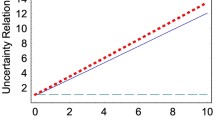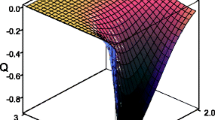Abstract
We obtain the squeezed coherent states (SCS) for a free particle with exponentially time-varying mass. We write these states in terms of the squeeze and displacement parameters on the time-independent Fock states. Thus, we find a condition on the displacement parameter such that the SCS can be considered semiclassical states. We show that it is possible to obtain the coherent states (CS) for a free particle with minimal uncertainty as long as the mass increases with the time. We analyze the transition probability of a system initially prepared in the time-independent Fock states to the free particle SCS.




Similar content being viewed by others
Data Availability Statement
Data sharing not applicable to this article as no datasets were generated or analyzed during the current study.
References
R.G. Littlejohn, The semiclassical evolution of wave packets. Phys. Rep. 138, 193 (1986)
M. Andrews, The evolution of free wave packets. Am. J. Phys. 76, 1102 (2008)
S. Hacyan, The quantum sling and the Schrödinger cat. Found. Phys. Lett. 9, 225 (1996)
B.E.A. Saleh, M.C. Teich, Fundamentals of Fotonics (Wiley, New Jersey, 2007)
E. Schrödinger, Der stetige ubergang von der mikro-zur makromechanik. Naturwissenschaften 14(28), 664 (1926)
R.J. Glauber, Coherent and incoherent states of the radiation field Phys. Rev. Lett. 10, 84 (1963)
J.R. Klauder, B.S. Skagerstam, Coherent States, Applications in Physics and Mathematical Physics (World Scientific, Singapore, 1985)
J.R. Klauder, E.C. Sudarshan, Fundamentals of Quantum Optics (Benjamin, New York, 1968)
H. A. Bachor, T. C. Ralph, A Guide to Experiments in Quantum Optics (Wiley-Vch, 2004)
R. Schnabel, Squeezed states of light and their applications in laser interferometers. Phys. Rept. 684, 1 (2017)
S. Dey, An introductory review on resource theories of generalized nonclassical light. J. Phys: Confer. Ser. 2038, 012008 (2021)
K. Zelaya, S. Dey, V. Hussin, Generalized squeezed states. Phys. Lett. A 382, 3369 (2018)
V.V. Dodonov, V.I. Man’ko, Theory of Nonclassical States of Light (Taylor & Francis Group, London, 2003)
J.B. Geloun, J. Hnybida, J.R. Klauder, Coherent states for continuous spectrum operators with non-normalizable fiducial states. J. Phys. A: Math. Theor. 45, 085301 (2012)
M. Andrews, Invariant operators for quadratic Hamiltonians Am. J. Phys. 67, 336 (1999)
V.G. Bagrov, D.M. Gitman, A.S. Pereira, Coherent and semiclassical states of a free particle. Phys.-Usp. 57, 891 (2014)
J. Guerrero, F.F. López-Ruiz, V. Aldaya, F. Cossío, Harmonic states for the free particle. J. Phys. A: Math. Theor. 44, 445307 (2011)
M. Maamache, A. Khatir, H. Lakehal, J.R. Choi, Analyzing generalized coherent states for a free particle. Sci. Rep. 6, 30538 (2016)
O.V. Man’ko, Coherent states of a free particle with varying mass in the probability representation of quantum mechanics. J. Rus. Las. Res. 43, 90 (2022)
A.S. Pereira, A.S. Lemos, Time-dependent coherent squeezed states in a nonunitary approach. Phys. Lett. A 405, 127428 (2021)
V.G. Bagrov, D.M. Gitman, A.S. Pereira, Coherent states of systems with quadratic Hamiltonians. Braz. J. Phys. 45, 369 (2015)
P. Caldirola, Forze non conservative nella meccanica quantistica. Nuovo Cimento 18, 393 (1941)
E. Kanai, On the quantization of the dissipative systems. Prog. Theor. Phys. 3, 440 (1948)
H. R. Lewis Jr., W. B. Riesenfeld, An exact quantum theory of the time-dependent harmonic oscillator and of a charged particle in a time-dependent electromagnetic field. J. Math. Phys. 10, 1458 (1969)
V.V. Dodonov, I.A. Malkin, V.I. Man’ko, Integrals of the motion, green functions, and coherent states of dynamical systems. Int. J. Theor. Phys. 14, 37 (1975)
A.S. Pereira, A.S. Lemos, F.A. Brito, Generalized para-Bose states. Eur. Phys. J. Plus 137, 957 (2022)
A.M. Perelomov, Generalized Coherent States and their Applications (Springer, 1986)
K. Zelaya, V. Hussin, O. Rosas-Ortiz, Constructing squeezed states of light with associated Hermite polynomials. Eur. Phys. J. Plus 136, 534 (2021)
A. Erdélyi, Bateman Manuscript Project, Higher Transcendental Functions, vol. 2 (McGraw-Hill, New York, 1953)
J.P. Gazeau, Coherent States in Quantum Physics (Wiley-VCH, Weinheim, 2009)
H.P. Robertson, A general formulation of the uncertainty principle and its classical interpretation. Phys. Rev. 35, 667A (1930)
V.V. Dodonov, E.V. Kurmyshev, V.I. Man’ko, Generalized uncertainty relation and correlated coherent states. Phys. Lett. 79(A), 150 (1980)
A.M. Awobode, Dynamical fluctuations of the rest. Found. Phys. Lett. 3, 167 (1990)
M.E.H. Ismail, P. Simeonov, Complex Hermite polynomials: their combinatorics and integral operators. Proc. Am. Math. Soc. 143, 1397 (2015)
S.J.L. van Eijndhoven, J.L.H. Meyers, New orthogonality relations for the Hermite polynomials and related Hilbert spaces. J. Math. Anal. Appl. 146, 89 (1990)
Acknowledgements
We would like to thank CNPq, CAPES and CNPq/PRONEX/FAPESQ-PB (Grant No. 165/2018), for partial financial support. ASL and FAB acknowledges support from CNPq (Grant Nos. 150601/2021-2, 312104/2018-9). ASL acknowledges support from CAPES (Grant No. 88887.800922/2023-00). ASP thanks the support of the Instituto Federal do Pará.
Author information
Authors and Affiliations
Corresponding author
Appendices
Appendix A: Determination of \(\Phi\)–function
We aim to get the \(\Phi\)–function present in the states (18). For this, we must substitute the states \(\left| \xi ,\zeta \right\rangle\) in the Schrödinger equation, and multiply it by \(\left\langle \zeta ,\xi \right|\), to have the following differential equation for \(\Phi\),
The derivative of parameters \(\zeta\) and \(\xi\) is found by assuming the definitions (13) and (14) together with Eqs. (11), as follows
The mean value of the operators \({\hat{H}}\left( t\right)\), \({\hat{a}}^{\dagger }\) and \({\hat{a}}^{\dagger 2}\) can be easily obtained by considering these operators in terms of the integrals of motion (6), in the form
Substituting the relations (A3) together with the condition (17), we can rewrite Eq. (A1) as follows
Therefore, the general solution of (A1) is given by
where C is an arbitrary real constant that will be fixed by imposing the normalization condition on the state \(\left| \xi ,\zeta \right\rangle\).
Appendix B: Normalization condition
We will determine the constant C by imposing the normalization of the states \(\left| \xi ,\zeta \right\rangle\). First, consider the generating function of the Hermite polynomials, see the formula \(\left( 10.13.19\right)\) in [29],
Thus, we can write (18), in the form
In what follows, let us calculate \(\left\langle \zeta ,\xi |\xi ,\zeta \right\rangle\), which will be given by
From the formula (10.13.22) in [29],
and imposing the normalization of the states \(\left| \xi ,\zeta \right\rangle\), i.e., \(\left\langle \zeta ,\xi |\xi ,\zeta \right\rangle =1\), we have C in the form
Appendix C: Completeness relation
Let us get the completeness relation for the states \(\left| \xi ,\zeta \right\rangle\). As we can see from Eqs. (13) and (14), the displacement and squeeze parameters are related to each other. Thus, we will obtain the completeness relation for the SCS by sweeping the entire complex plane of the constant \(\varphi =\varphi _{0}\). Therefore, we must have
where \(\eta \left( u_{1},u_{2}\right)\) is a weight function, which will be fixed in order to ensure the completeness relation (C1).
Consider the real functions \(z_{1}\) and \(z_{2}\), in the following form
where we made the substitutions \(\zeta =\left| \zeta \right| e^{i\theta _{\zeta }}\) and \(f=\left| f\right| e^{i\theta _{f}}\). From here, we can write
Thus, the element of integration \(d^{2}\varphi\) in the new variables \(z_{1}\) and \(z_{2}\) takes the form
Therefore, we can rewrite (C1), as follows
Now \(\left( i\right)\) making the following identification
(ii) considering the orthogonality of the Hermite polynomials [34, 35],
and \(\left( iii\right)\) choosing the weight function \(\eta \left( z_{1},z_{2}\right) =\left( \pi \mu \right) ^{-1}\), we will have
Thus, we show that the resolution of the identity for the SCS of a free particle is satisfied in the complex plane of the constant \(\varphi\).
Rights and permissions
Springer Nature or its licensor (e.g. a society or other partner) holds exclusive rights to this article under a publishing agreement with the author(s) or other rightsholder(s); author self-archiving of the accepted manuscript version of this article is solely governed by the terms of such publishing agreement and applicable law.
About this article
Cite this article
Pereira, A.S., Lemos, A.S. & Brito, F.A. Squeezed coherent states for a free particle with time-varying mass. Eur. Phys. J. Plus 138, 363 (2023). https://doi.org/10.1140/epjp/s13360-023-03974-7
Received:
Accepted:
Published:
DOI: https://doi.org/10.1140/epjp/s13360-023-03974-7




